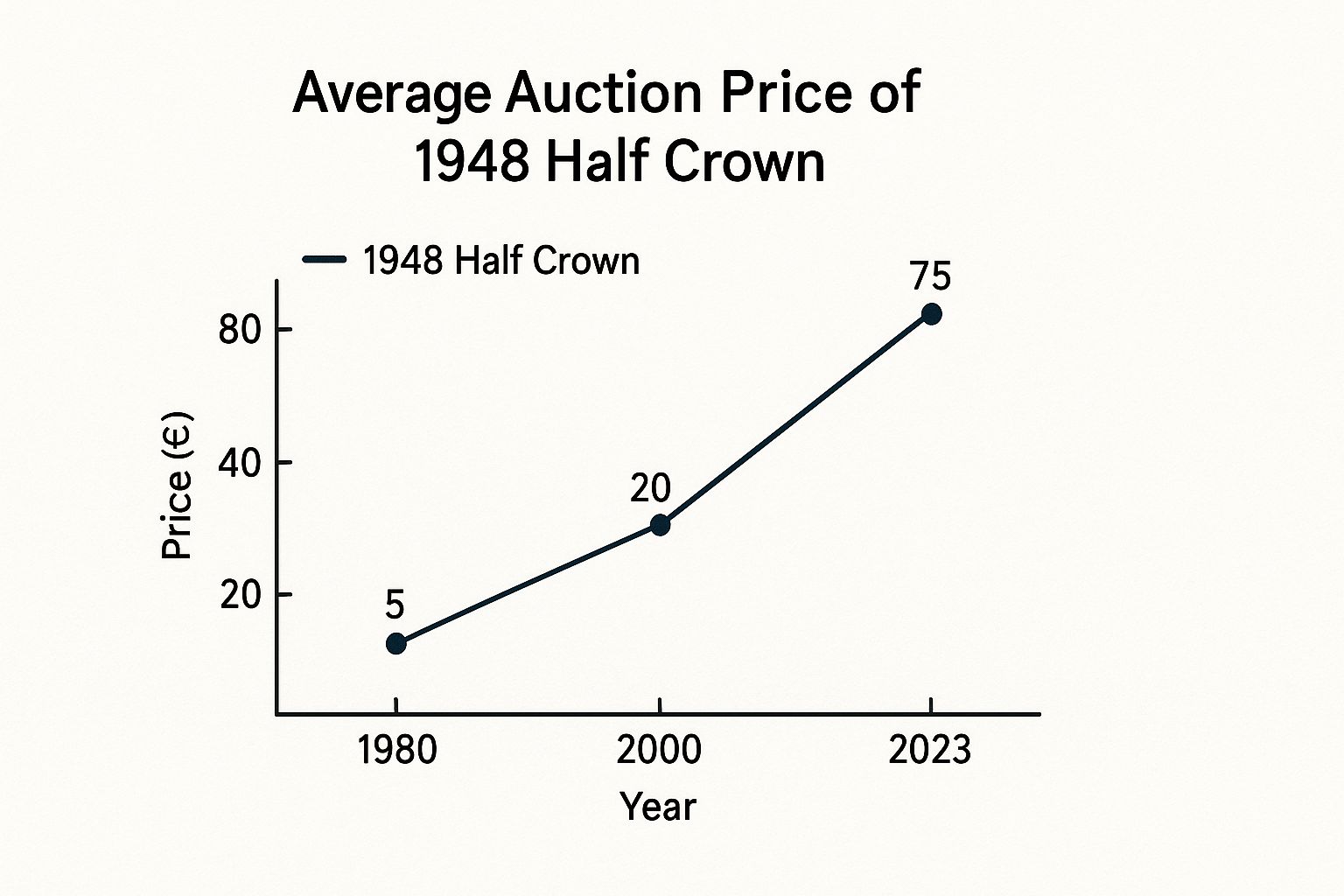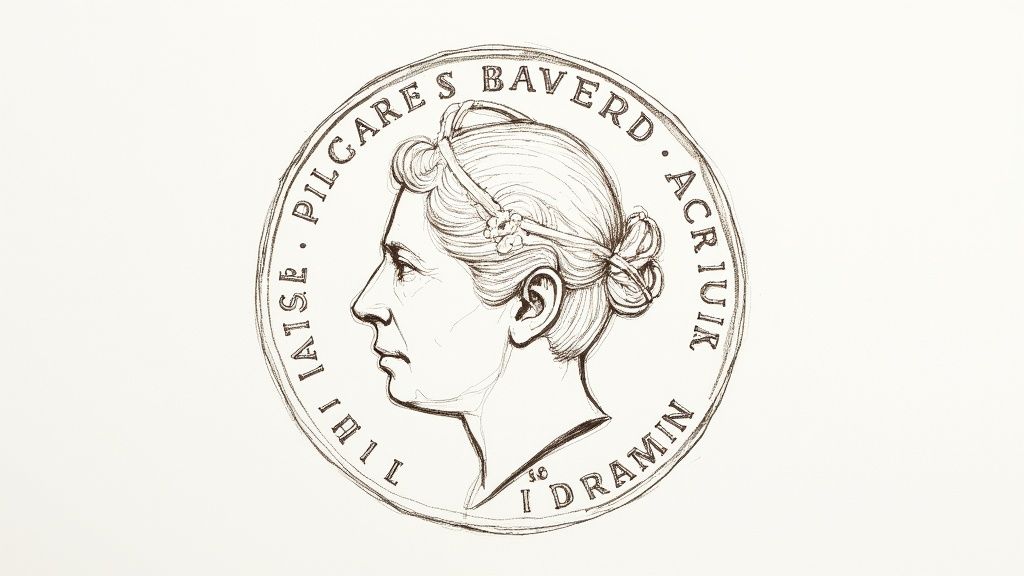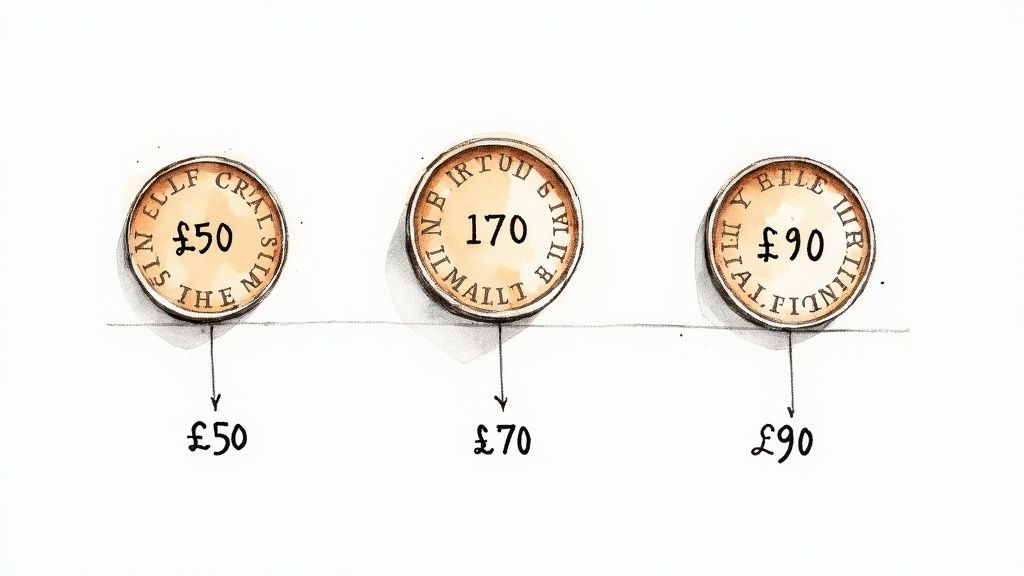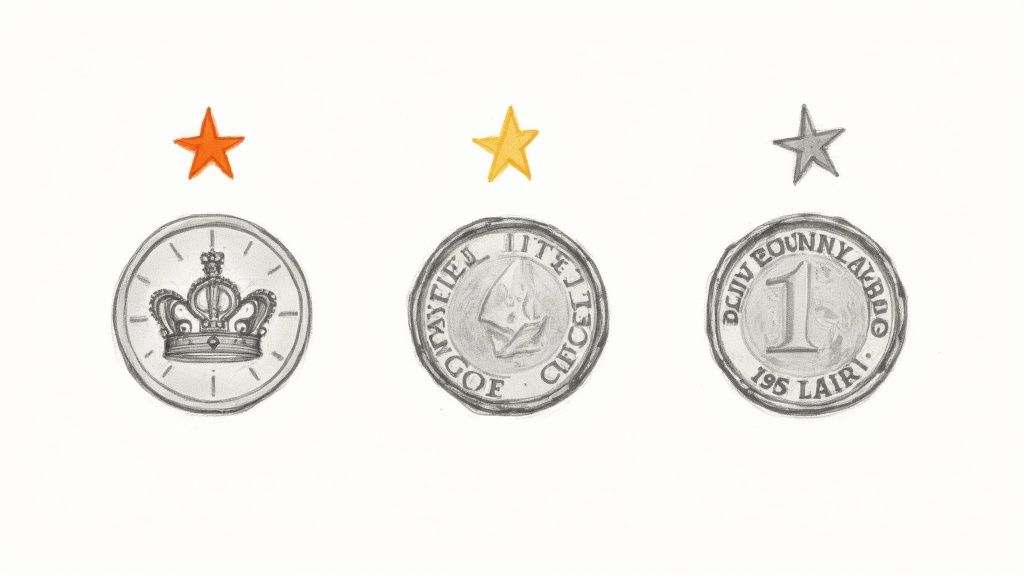When trying to figure out what a 1948 half crown is worth, you’ll find the answer isn’t a single, straightforward number. Instead, its value sits on a sliding scale, dictated almost entirely by its condition. A well-worn coin that’s passed through countless hands might only be worth its metal value, often less than £1. On the other hand, a perfect, uncirculated specimen can easily sell for £7 or more.
This massive difference is exactly why understanding a coin's grade is so crucial for any collector.
Your 1948 Half Crown Value Explained
The 1948 half crown is a wonderful little piece of Britain's post-war story. However, a massive number were minted, which means its rarity isn't the main driver of its value. Instead, it all comes down to its state of preservation.
Think of it like a vintage car. A rusty old banger that's seen better days is a project, maybe worth something for its parts. But one that's been kept under a dust sheet in a garage, in mint condition? That’s a prized collector's item. The very same principle applies here—the coin’s journey through time determines its value today.
To give you a clearer idea, here's a breakdown of what you might expect based on the coin's grade.
1948 Half Crown Estimated Value by Grade
The table below gives you a solid estimate of the market value for a 1948 half crown based on its condition. As you'll see, the better the grade, the more a collector is willing to pay.
| Grade | Condition Description | Estimated Value |
|---|---|---|
| Very Good (VG) | Heavy wear, major details are flat but legible. | £0.20 |
| Fine (F) | Moderate wear but key features are still clear. | £0.50 |
| Very Fine (VF) | Light wear on the highest points, still quite sharp. | £1.50 |
| Extremely Fine (EF) | Very light wear, almost all original detail is visible. | £3.00 |
| Uncirculated (UNC) | No signs of wear, as it looked leaving the mint. | £7+ |
These values are, of course, a guide. The market can shift, but this gives you a reliable starting point for assessing your own coin.
The chart below really drives home how much collector interest has grown over the years, especially for those top-grade coins.

As you can see, that sharp climb in recent decades shows a healthy and growing appetite for well-preserved pieces of history. To see how this coin stacks up against others from different years, you can dive into our complete guide to half crown coin values.
The Story Behind Your Post-War Coin

Every coin is a tiny time capsule, and the 1948 half crown is no exception. It drops you right into the heart of a Britain picking up the pieces after the Second World War. This isn't just a bit of old currency; it's a direct link to a time defined by grit, resilience, and making do.
When you hold this coin, you're holding a piece of King George VI's reign. The design itself tells a compelling story. On the "heads" side, you'll find Humphrey Paget’s uncrowned portrait of the King—a deliberate choice signifying a more modern monarchy, one looking to the future instead of being stuck in the past.
A Coin Forged in Austerity
The immense economic strain after WWII had a direct impact on how this coin was made. Britain was saddled with colossal war debts, and the silver traditionally used for coinage was sold off to help pay them down. So, the half crown, which had been a silver coin for centuries, was now struck from a tough cupro-nickel alloy.
This wasn't just a practical switch; it was deeply symbolic of the era. The entire nation was tightening its belt, and the money in people's pockets was a daily reminder of that shared sacrifice. Flip the coin over, and you'll see the reverse, designed by George Krueger-Gray. It features a bold shield of the Royal Arms, a proud symbol of a national identity that refused to be broken.
Understanding this context transforms the coin from a simple piece of metal into a powerful artefact. It represents a specific moment when the country was tightening its belt but standing firm, making the value of a half crown 1948 more than just monetary.
The Royal Mint churned these coins out on a massive scale to keep the recovering economy moving. In fact, the 1948 half crown had an enormous mintage of approximately 71.17 million pieces, making it one of the most common half crowns ever produced.
This cupro-nickel workhorse, made of 75% copper and 25% nickel, became a familiar sight in daily transactions across the country. It weighed 14.14 grams and measured 32.3 millimetres across. If you're curious, you can watch a detailed video about the 1948 half crown's production facts to learn more.
How to Grade Your Coin Like an Expert

In the world of coin collecting, one thing matters above all else: condition. The grade of a coin is simply a way of describing its state of preservation, and it’s often the biggest factor separating a piece worth a few quid from one worth a serious sum. The good news? You don't need a high-powered microscope to get a solid idea of your 1948 half crown's condition.
I like to think of a brand-new, uncirculated coin as having a full tank of detail. Every time it gets passed over a counter or jingles in someone’s pocket, it loses a tiny bit of that detail. Your job as a collector is to figure out just how much is left. The highest, most exposed parts of the design always wear down first, so that’s where you need to focus your attention.
Checking the Key Wear Points
To make a good assessment, you need to know exactly where to look. These two high points on the 1948 half crown will show signs of wear long before the more protected parts of the design.
- King George VI’s Portrait: Have a close look at the details in the King’s hair, especially the area just above his ear. On a coin in great shape, you’ll be able to see individual strands, sharp and clear. If it’s seen a lot of circulation, that same area will be smoothed over and flat.
- The Royal Shield: Flip the coin over and examine the intricate lines and patterns inside the shield. An Extremely Fine (EF) coin will still have most of these delicate details, but a Fine (F) example will look noticeably flattened and worn.
The difference in sharpness between a high-grade coin and a lower-grade one is exactly what drives the value up.
Damage Control: What Kills a Coin’s Value
Beyond the normal wear and tear from circulation, any sort of physical damage can absolutely crush the value of a half crown 1948.
A coin's grade tells the story of its life in circulation. Damage, on the other hand, is like a chapter being ripped out. Even a coin with very little wear can lose nearly all its collector appeal if it’s been scratched or improperly cleaned.
Keep an eye out for obvious scratches, nicks on the rim, or signs of harsh cleaning—this often looks like an unnaturally bright, shiny surface covered in tiny, parallel hairline scratches. These are major red flags for serious collectors.
If you'd like to get deeper into the finer points of assessing condition, this expert guide to British numismatic value is a fantastic resource.
What Really Drives Your Coin's Value?

Beyond the simple grade a coin receives, several other factors come into play when working out the market price of your 1948 half crown. You might look at the mintage figure—over 71 million—and think it must be common. And you'd be right, but that huge number hides a fascinating paradox.
Think of it this way: the more coins that flooded into circulation, the fewer managed to escape the daily grind of being spent, dropped, and scratched. Most of them lived a hard life. This is why a coin that seems common at first glance can become genuinely scarce in pristine, untouched condition.
This scarcity in top-tier condition is what really drives its numismatic value. A collector isn't just buying a piece of cupro-nickel; they are paying for a story of survival and a tangible piece of post-war history.
Numismatic vs. Metal Value
It's absolutely vital to understand the difference between the two types of value a coin can have. This distinction is at the very heart of what makes collecting so compelling.
- Intrinsic Value: This is simply the melt value of the metal the coin is made from. For a cupro-nickel 1948 half crown, this is incredibly low—just a few pence.
- Numismatic Value: This is what a collector is willing to pay. It’s based on rarity, condition, and historical importance, and for any collectable coin, it will always be far higher than the intrinsic value.
Essentially, you are collecting a story, not just a lump of metal. This is exactly why a perfectly preserved specimen can fetch a price many, many times higher than its metal content is worth.
The real value of a half crown 1948 lies not in the metal it's made from, but in the journey it has survived. An uncirculated coin tells a story of preservation against incredible odds, and that’s what collectors truly prize.
Finally, never underestimate the role of collector demand. Trends in the numismatic community can shift, sparking fresh interest in specific eras or monarchs. If, for example, more collectors suddenly take an interest in George VI coinage, you can expect to see a gentle lift in the market price for well-preserved half crowns from his reign.
What a Half Crown Could Buy in 1948
To really get a feel for this coin, you have to picture Britain in 1948. The value of a half crown back then wasn't just a number on a piece of metal; it was real, tangible spending power for a nation still finding its feet after the war. So, what could you actually get for two shillings and sixpence?
Think of the half crown as the workhorse of the wallet. It wasn't just loose change you'd use for a bag of sweets, but it wasn't a banknote you'd save for the big weekly shop, either. It was that perfect in-between coin for everyday things that mattered, making it a familiar sight in pubs, shops, and homes across the country.
This context is what separates a collector's item from a piece of living history. This wasn't just metal; it was a ticket to the cinema or a Sunday roast. Its journey as an everyday coin came to an end in 1970 when it was finally demonetised.
Real World Spending Power
A half crown was worth one-eighth of a pound sterling, a pretty hefty sum before decimalisation came along. For a bit of perspective, a single half crown could comfortably pay for:
- A ticket to the pictures to see the latest film.
- A round of several pints down at the local.
- A decent joint of meat from the butcher for the family's Sunday dinner.
- Entry into a professional football match to see your team play.
In post-war Britain, a half crown was a proper measure of value. It could turn an ordinary day into a special one or cover a household essential, making it a cornerstone of the weekly budget for millions of families.
In old money terms, the 1948 half crown was two shillings and six pence (2/6). If you adjust for inflation, that works out to around £5.83 in today’s money. It really gives you a sense of what that coin meant to people at the time. You can read a bit more about its place in the old system on the Wikipedia page for the pre-decimal half crown).
Getting Your Half Crown Valued or Sold
So, you’ve got a good handle on your coin’s condition. What’s next? The next step is figuring out what it’s actually worth in today's market and deciding what to do with it. Confirming the value of a half crown 1948 can be done through a few reliable channels, and the best one for you really depends on your goal.
For a quick, no-fuss appraisal, popping into your local coin shop is an excellent place to start. A good dealer can often give you an assessment on the spot and might even make you an offer. This is probably the simplest route if you're just looking to sell directly.
Online Marketplaces and Auction Houses
If you want to reach a much bigger audience, online platforms are the way to go. eBay is a popular choice for more common coins, but don’t forget to account for their fees when setting your price. Make sure you take clear, well-lit photos of both the front and back—it’s amazing what a difference good pictures make. Highlighting any unique features in your description is also key to catching a buyer's eye.
Now, if you suspect you're holding a truly exceptional, high-grade specimen, then a specialist numismatic auction house is your best bet. These auction houses are connected to a global network of serious collectors who are prepared to pay top-tier prices for premium coins.
The key to a successful sale always comes down to good presentation and accurate information. Whether you're listing it online or showing it to a dealer, having a clear understanding of your coin's grade and story will help you get a fair price.
For anyone who just wants to verify a price, online guides and recent auction results are a treasure trove of data. And finally, if you're getting ready to sell, our guide on how to sell a coin collection offers some practical tips for navigating the whole process.
A Few Final Questions About the 1948 Half Crown
Even after you get the hang of grading and checking market prices, a few common questions always seem to pop up about the 1948 half crown. Let's tackle them head-on so you can feel confident in your assessment.
Is the 1948 Half Crown Made of Silver?
This is probably the most frequent question, and the answer is a straightforward no. The days of silver coinage were over by this point. Facing post-war economic realities, the Royal Mint had switched to a cupro-nickel alloy (75% copper, 25% nickel).
This means the coin's value isn't tied to its metal content, which is minimal. All its value comes from its collectability.
Are There Any Rare Varieties?
Because so many were minted, a standard 1948 half crown is very common. The real hunt is for minting errors. These are the little quirks that make an otherwise ordinary coin special.
Keep an eye out for things like die breaks (or "cuds"). This happens when a small piece of the die breaks off, leaving a raised, unstruck blob of metal on the coin's surface.
An error turns a common coin into a unique one. While a standard 1948 half crown is worth a few pounds, a noticeable error like a cud can make it highly sought after by specialists.
Does the 1948 Half Crown Have a Mint Mark?
Nope. British coins struck at the Royal Mint in London during this era didn't carry mint marks. So, if you're scouring your coin looking for a tiny letter and can't find one, don't worry—it's not supposed to be there.
Whether you're looking to identify a potential error coin or add a high-grade specimen to your collection, Cavalier Coins Ltd has the expertise and inventory to help. Explore our curated selection of British coinage today at https://www.cavaliercoins.com.

